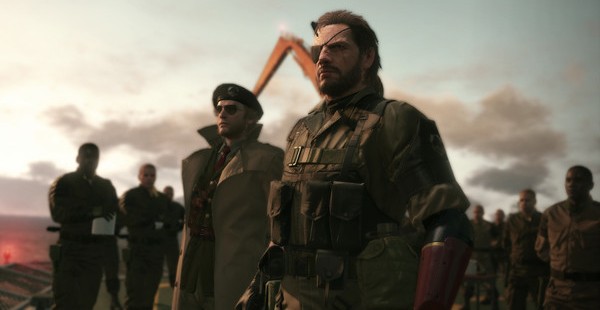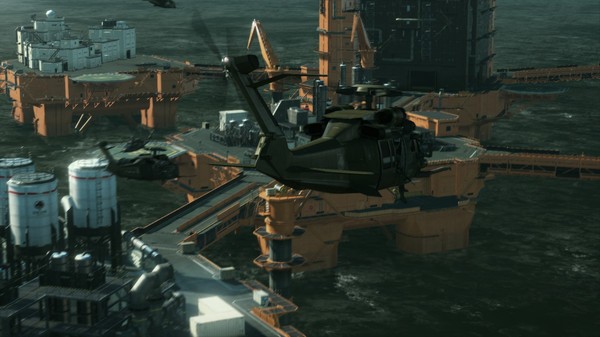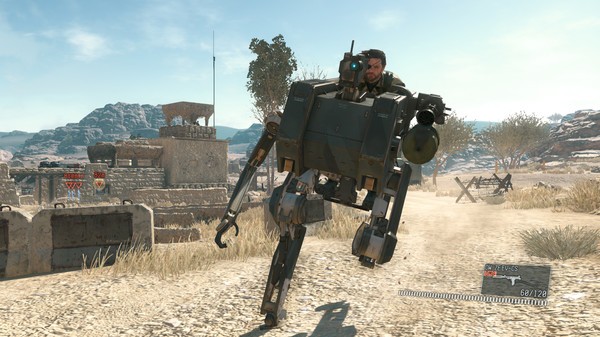
Due Diligence: Village
Leigh Harrison revisits familiar haunts.
Although I’ve lied about the matter countless times in the past, the truth is that I don’t like stealth games a great deal. I’ve not got the patience or self discipline to take my time, memorize the movements of rooms full of guards, and generally “be stealthy.” I’m too lazy for it. I’ve always found the Metal Gear Solid games to be awfully restrictive for my tastes, and so I was bewildered but intrigued upon hearing that Metal Gear Solid V would be an open world sandbox stealth game. As a statement of intent, “freeform stealth, bro” is a fairly ambitious one, and in parts MGS V’s creative take on the genre, especially when it comes to world building, is as striking as you’d expect from its bold claims. At the same time though, its inability to escape the gnarled clutches of open world conventions means that it is a deeply conflicted experience, one that can astound and confound in the same breath, and one that ultimately pushed me away more forcefully than any previous MGS title— ironically enough because it is filled with the same sorts of restrictions it seeks to eradicate.
Da Wialo Kallai is a little village in the middle of the Afghanistan desert. It sits on either side of a large road, bordered by a stream to the west and a big hill to the east. There’s not much to the north or south except for the great expanses of empty, open ground that make up much of MGS V’s world. The village itself is full of the things you’d expect from both a small settlement and a Metal Gear game: buildings, walls, and other assorted surfaces one can skulk behind and around. This is good, because the village, like the rest of the game, is only populated by bad men you don’t really want seeing you. I’ve been to Da Wialo Kallai at least a dozen times, which means I’m now in the enviable position of being able to say I’m as familiar with it as the part of North London where I actually live.
According to the venerable online resource that is the Metal Gear Wiki (Tactical Espionage Encyclopedia—proving once and for all that anything can be taken too seriously), you only have to visit the village twice. Written in a curiously phlegmatic way, as if the events of the game were simply a matter of public record, the wiki tells me that protagonist Venom Snake went there once to find information on a friend and then again to kill some Soviet commander men. Strangely absent are the handful of times he went back to kidnap various important soldiers he was told would be an asset to his private army. Or the two other times he rescued different hostages from the same room in the same building—one on a Tuesday, the other on a Saturday afternoon. Or even that time he attached a giant balloon to a sheep and whisked it away to be part of his grotesque personal oilrig zoo.

The Tactical Espionage Encyclopedia doesn’t make mention of these insubstantial anecdotes because they are all unimportant. Like the bloke Churchill sent out for more brandy and cigars or all but one of Elvis Presley’s bathroom breaks, those other times I visited Da Wialo Kallai are lost to history because nobody cares to hear about them. And I can’t really blame anyone—the other ten times were strikingly similar to the two “important” ones. The thing about Da Wialo Kallai, and for that matter lots of the places and tasks that make up MGS V, is that you can do pretty much the same thing in any given situation.
Apart from the first time when I had no option, I always approach the village in the same way, starting from that big hill to the east. I land in my chopper blaring out Kim Wilde’s “Kids in America,” scan the entire settlement for enemies, and then proceed down the hill and around the village. I remove all the bad men from the foot of the hill, then head to the south and clear the bit of the settlement that borders the nothingness of the desert. Next I whip up the village’s western end as I hug the stream, turn right, and dispose of any stragglers to the north who were too stupid to realize something terrible has been afoot for the last seven or so minutes. With these out of the way I then descend on the two-story command center in the middle of the village, which will inevitably be filled with collectible rubbish and any hostages I might need if that’s the purpose of this particular infiltration. After that I run around all the now nicely deserted buildings and remove anything of value that isn’t nailed down. If viewed from above, these trips to Da Wialo Kallai would look a lot like Snake was trying to draw a neat square around the village with his feet, and then run around stealing things as he maniacally colors that square in. This could conceivably be a legitimate coping mechanism he’s developed to distract himself from the boredom of having to repeatedly return to the same place again and again and again.
Having said all this, I’m not so sure I completely disagree with the concept of revisiting the same place. I’ve said this elsewhere, but big ticket games are terribly wasteful with their locations. Something like a Far Cry is filled with temples, amphitheaters, and castles the player is only ever going to run through once, at breakneck speed. The “action” part of these games necessitates a degree of forward motion that prevents us from revisiting or stopping to have a poke around. Things are on fire, things are trying to kill us, things are filling with water, and things are hurtling towards precipices. There’s always something going on that needs to happen somewhere, so we build it a new home each time.
MGS V provides a counterpoint to this and suggests that we do all the different activities that make up an action game in the same handful of places. The problem with this is that it highlights the lack of variety the game has to offer. Again, I’ve touched upon this before: there’s only one way to play MGS V properly and in a way that maximises success. You can kill all the bad men in all the villages and outposts from the very beginning, but you just won’t get very far. A big component of MGS V is building an army of “recruits” you abduct from the field by attaching them to big balloons. Each soldier in the world has a set of stats, and a lot of Snake’s time is spent looking out across battlefields for men with better numbers so he can steal them to bolster the ranks at his deep sea fortress. Upgrades are unlocked when enough soldiers of a certain rank all live there. All this means is that you cannot kill people in MGS V; it just isn’t done. And if you do murder everyone you’ll end up sorely under equipped as the game gets harder. No: it is highly advisable that every enemy be knocked unconscious and then airlifted back home to be brainwashed.

I’m happy to take the non-lethal approach, and I’m not even that bothered about the base building/man abducting aspect of the game being so time-consuming and dull. What is most troublesome is how this flattens every possible encounter into being identical. Every bad man should, ideally, be taken home with you from a mission, seeing as how he can be useful at some point and in whatever tiny capacity. Likewise, every tank, APC, goat, machine gun, jeep, truck, bear, mortar, and crazed zombie-soldier-from-the-past is best taken back to base. The game demands that you look at enemies and their tools not as adversaries but as prospective subordinates, which makes the whole thing an exercise in not shitting on your own doorstep. These men with their guns and cars can all theoretically be your men and guns and cars, so you don’t want to get a scratch on any of your fragile, treasured, would-be possessions. A place like Da Wialo Kallai becomes a meat market; no matter how many times you clear it of a cadre of bad men it is swiftly repopulated once you leave the area, ready for you to return and repeat the process anew. Snake needs to constantly bolster his force through kidnap and appropriation, quickly becoming a pacifist kleptomaniac as the game turns into one long, unabated theft spree.
This is tolerable for a time with the main missions—the “find my friend” and “kill abduct the commanders” types that have a bit more about them—but all the side content trips to Da Wialo Kallai begin to show how samey everything is. The game has an infuriating tendency to pretend that you can kill things even though we all know you can’t. Most of the main mission briefings are worded in ways that suggest heads and buildings and vehicles should explode. The side activities are meant to be different in that they are all explicitly about non-lethal Tactical Espionage Operations. You’re sent in to rescue a hostage, or capture a soldier, or steal a sheep. But because the whole game revolves around not killing man, machine, or beast to begin with, what should be satisfying one-off little bits of fun just become yet more situations where you’re knocking something out and abducting it.
Now don’t get me wrong: there are many tools at one’s disposal with which to incapacitate a bad man in MGS V. Rubber bullets, sleep grenades, electric shocks, choke holds, and flying robotic fists are all viable options. From my “if it ain’t broke…” perspective, however, these only exist as far flung and zany options. The game gives you a silenced tranquilizer pistol from the very beginning, which, when combined with sneaking, strangulation, and a steady stream of upgrades generated by your offshore sweatshops, is pretty much all you’ll ever need—unless, of course, you force yourself to be more creative.
I’m willing to admit that I’m too lazy and risk averse to ever wring out everything from a game like MGS V, but I don’t think the onus should be on me to do so to begin with, which is why I didn’t try out many of the bewildering number of possible courses of action I could have taken in MGS V. There are what feels like hundreds of guns, gadgets, and pharmaceutical products that Snake can take into the field, all of which might well be very useful. There’s the inflatable versions of Snake himself, used to create distractions, cages for trapping animals, and a cigar that speeds up the passage of time. There are assault rifles, shotguns, pistols, and submachine guns. There are landmines, tape recordings of enemy soldiers, mini bipedal battle tanks, massive missile launchers, and pills to calm Snake’s nerves. But there’s no point in any of them because all you really have to do for the entire game is knock men out and attach them to balloons. You can do this in a great many ways, but the easiest is to just sneak up on a man and choke him out, or, failing that, put him to sleep with a tranquilizer dart. Anything more elaborate than that is unnecessary, and seeing as how I quickly tired of the abduction conceit at the game’s core, I wasn’t looking to drag out my time with MGS V to help it prove its own worth.

MGS V could have been an interesting deconstruction of the spatial excesses inherent in open world games had it not been so utterly dull and, somewhat ironically, so enraptured by its own horribly indulgent subsystem. I touched upon it briefly earlier, but most of its two massive maps are largely made up of nothingness. There are about 20 places the size of Da Wialo Kallai, and apart from the minor distraction of 30-odd little checkpoints, the bulk of the game takes place within them. Everything else—I’d say conservatively 75-80% of both landmasses—is just empty space where nothing happens. It’s a refreshingly literal take on an “open” world, and I appreciate the attempt to focus squarely on designing a few dozen multi-purpose locations. And these places really are ripe for variety and reuse, especially when you factor in all of the game’s many temporal, weather, enemy, and weaponry variations. The problem is that MGS V is still a very standard open world game in many other respects. Given this, it has to allow the player some (illusion of) freedom whilst at the same time corralling and guiding them at every turn. MGS V chooses to mete out its progress through the army building system, but in tying so much into it it becomes unavoidable and thus dictates how the player is able to act in any and all situations.
MGS V is a game of contradictions. Its inventories and systems are filled with variety and seemingly inexhaustible choice. Its world is, by design, a void periodically interrupted by flashpoints where mechanics and space come together and blossom. The game should be a staccato affair of constantly shifting strategies, moods, and paces. This, though, never happens, because it is too wedded to the conventions it seeks to disrupt. Its army building should be a complementary system used to embellish a wealth of options already available to the player. In fundamentally linking progress to a single-minded method of interaction, Metal Gear Solid V squanders all that it could be and encourages you to play every new encounter like the last in order to ensure maximum efficiency. In this way it undermines its own meditations on the genre and neuters its reusable spaces. Every visit to Da Wialo Kallai is meant to be different, but because the game can’t escape the genre it seeks to critique, each trip is less eventful than popping to the store for a carton of milk.
Leigh Harrison lives in London, makes DVDs for a living and owns a hamster. He likes canals and rivers a great deal, and spends a lot of his time walking. He occasionally says things about videogames on the Internet, and other things on The Twitter.